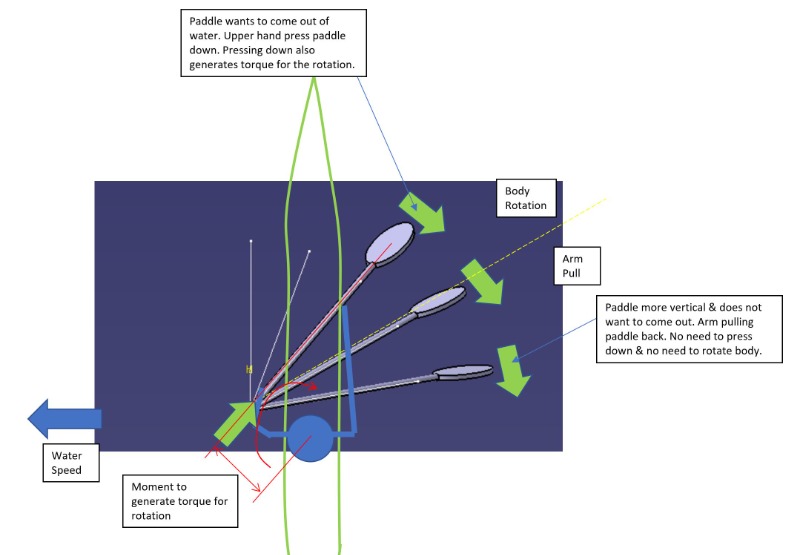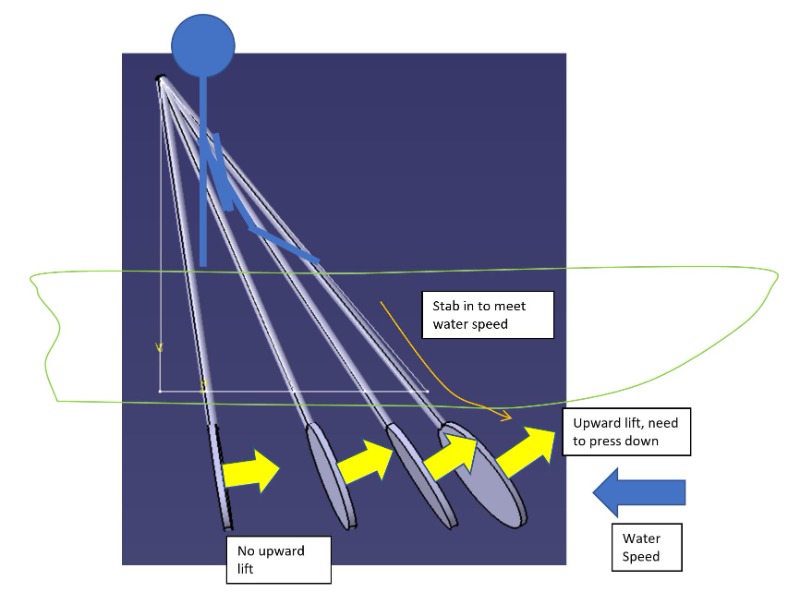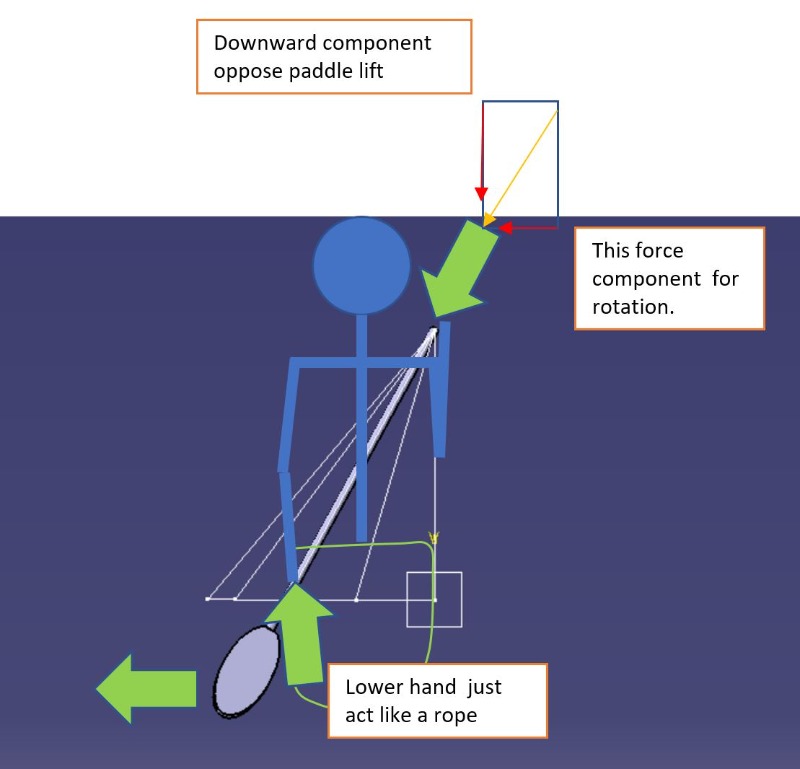- Posts: 298
- Thank you received: 45
Forward Stroke Conundrum
I used to get pretty sore shoulders too. They now hardly bother me at all and I put that down to:
1. theraband exercises to strengthen rotator cuff
2. sticking to safe technique
3. change of paddle from an olympic-associated brand to the Gara Odin small with a more flexible shaft and slightly smaller blade.
4. avoiding flat out sprints with the associated loss of form.
When I do sprint for a wave I drop the paddle angle a bit and really try to make the legs and rotation do most of the work.
These are all great basic reminders, especially as we get older to check the ego at the door and "stay within the envelope"
Please Log in or Create an account to join the conversation.
1) No matter how high and short duration the force is, you can produce more power if you remain elastic. Sprint doctrine is always all 'stiff ankles!' but if you look at slow motion video, especially of Bolt, you see how elastic the ankles are--and they have to be because at initial ground contact the force is almost entirely vertical and the leg (esp the ankle) must translate this to horizontal in that split second by storing and releasing energy elastically.
2) Fascia respond best to extremely gradual frequent progressive loads at sub maximal levels of volume or intensity. Once you have a base, hitting at a maximal load once or twice a week may be of benefit to get that last bit faster, but the safest way to build is to stay well within your limits on any given workout so you can workout fresh sooner.
My issue with paddling right now is kinda opposite, I think I am not loading the initial part of the stroke where the body is best leveraged heavily enough, so I am working to hard in the mid/end.
Please Log in or Create an account to join the conversation.
Just analyzed some video Balint Kopasz because I remembered him being pretty unique. It looks like he completely bypasses use of the rear delt entirely. His elbow stays really close to the boat from the beginning to the end and bends at the elbow and swings the forearm outwards at the late mid/end. This would imply the lat is loaded through most of the stroke, then transitions to the external rotators (with a short lever). The part of the stroke that gets me is arm extended out to the side at 60 degrees with a large space between the elbow and body, and Kopasz never reaches that position.
This probably varies from person to person but my rotators are together stronger than my rear delt--especially if combined with a forearm length rather than arm length lever.
It is amazing how many different techniques are used at the top level of paddling!
Please Log in or Create an account to join the conversation.
- Wombat661
- Visitor
To get more engineering, the more I think about it, the forces involved are not so simple. Had to do a sketch. I think from catch to about 1 o'clock, there is lifting force on the paddle. After 2 o'clock, paddle is more vertical, and is less rotation, but more pull with the arm.
I believe the rotation torque is taken care of to some degree by the upper hand pushing down and pushing the paddle to rotate. See the different view diagrams. I get the sense that rotation can be done without using much upper body.
Attachments:
Please Log in or Create an account to join the conversation.
To clarify, when I say horizontal plane, I mean that quite literally. Any component of force not parallel with the force of gravity is in the horizontal plane.
For my current stroke, anything parallel with gravity is quite easily handled by the top arm and by the lat of the bottom arm.
The force I struggle to hold is the one perpendicular to the force of gravity and parallel to the direction of the boat.
Breaking it down further, I have no trouble at the beginning of the stroke. I also have no trouble with the 'bottom arm acting as rope' component of this vector as that is entirely held by the lat. The problem occurs with the component of the vector perpendicular to the arm in the horizontal plane. (See my first diagram in the thread.)
If the paddle face is kept directly backward (which is most efficient) this force is greatest the farther the hand is from the boat and later in the stroke.
Imagine the bottom arm actually is a rope--in that case it has zero say over a vector perpendicular to the rope. It may take a moment to visualize this next point, but the top arm also has very little say over this vector because of how vertical the paddle shaft is in the mid/end of the power phase. In order for the top arm to contribute meaningfully it would have to be practically grazing the boat deck.
Note:
When this issue first came up for me I thought maybe it could be handled by the top arm and treated the bottom arm like a rope. In order for the top arm to handle that vector it needed to use external rotation of the forearm. Now imagine the length of that lever and how sore my thumb was the next day! I could barely eat cereal
Please Log in or Create an account to join the conversation.
Solution:
Find a good coach - preferably of Olympic standard.
Take videos from front, back and both sides - send to coach for analysis
Buy an instrumented paddle (onegiantleap.co.nz/)
Work with your coach, - do what he says
Watch videos of genuinely expert paddlers (Balint Kopasz; Max Hoff; Adam van Koeverden; Knut Holmann) Visualisation is a powerful tool) Yes, they're all K1 paddlers, but correct technique is equally important in a ski.
Avoid advice like "leg drive doesn't matter". Watch Kopasz front-on video from his most recent gold medal and tell me that he's just moving his legs for show...
Enjoy the journey.
Please Log in or Create an account to join the conversation.
As you can likely tell, I love to talk, and to try to figure things out--which is how I like to enjoy the journey.
Also, describing a 4 dimensional entity in our 1 dimensional language precisely requires some significant unraveling!
Sadly, I doubt Kopasz' coach would be willing to spend any time on a lowly rec paddler like myself, but to address your other points...
Leg Drive: I model my leg drive after Kopasz, and that was the reason for my flexibility training over the winter. I don't plan to scrap it after reading one forum comment. However, sometimes analyzing a seemingly 'wrong' idea rather than immediately dismissing it can give a more nuanced understanding of the dynamics. (E.g. How is it best to time the leg drive and what is the optimal rate of force production for them?)
Emulating K-1 pros:
1) When I paddle at 11 mph (Kopasz 1k speed) - rear delt is not a problem at all, the issue I run into is energy systems/fitness.
2) After the analyzing I have done in this thread, everything pros do technically makes sense to me except the top arm.
1km pro paddlers almost always punch the top arm at the beginning/middle of the stroke which reduces the possible weight that can be applied vertically by the top arm (okay maybe they are just strong). More importantly it creates a negative angle of the paddle while it is submerged in the water which would seem to drive the boat downward.
200m paddlers tend to not do this, having patient top arms and lifting the boat up. The great marathoner Hank McGregor also had a patient top arm.
But everywhere in between I see tons of fully outstretched top arms during the middle of the stroke. In the absence of having Kopasz' coach here to explain, might you have an idea on why this is so widespread among middle distance paddlers, but not with sprinters?
EDIT: Exception I just found. In the 1k, Max Hoff has a very patient right top arm and a very early extended left top arm. Somehow that asymmetry worked for him lol.
Please Log in or Create an account to join the conversation.
Belacqua, I suspect that you are quite strong.
I also suspect that you are twisting your spine (body). That will load the deltoids in the latter part of the stroke (try sitting in a chair, swing on the chair to one side, then try the same twist but keeping bottom still and twisting spine; the second movement creates tension in the deltoids).
A good paddling drill (to be done on calm water), is to concentrate on a really good catch, then pulling the boat past the paddle.
most of the time, we concentrate on putting effort through the paddle stroke, pulling it back. It is actually more efficient to lock the blade in the water and pull on it.
When doing this drill, reduce your power, concentrate on getting that lock in the water.
It can be very helpful to have a speed readout - you will be able to see the effect of changes to the stroke.
Please Log in or Create an account to join the conversation.
- balance_fit
-

- Offline
- Junior Member
- Posts: 35
- Thank you received: 5
Coaches are excellent resources. But coaches also need to understand their athlete's needs. A paddler with a long torso, another one with powerful legs, the other with tight hamstrings, they'll all need adjustments in their techniques.
I remember my coach in high school xc running. He always instructed me not to jump, to keep my body close to the ground. No matter how hard I tried, I always jumped my strides because I felt elastic. Decades later, having worn out my knees and feet, I finally understood my coach: don't jump, yes, but also, lean forward, feel that you're falling, and keep your feet under your body, never ahead.
What does this has to do with paddling?
Leaning slightly forward loads our muscles elastically. It is felt as increasing pressure on the footrest.
Using an elastic, or rebound paradigm, paddling might feel like this: Upon catch, along the shaft and through the upper arm, we apply our body weight onto the blade. We catch ourselves falling forward onto the water, our torso mass engages leg drive, while through the bottom arm we further express the torso's weight on the blade, in a pulling direction. Rotation happens elastically, as a result, and the ski is pushed forward.
As this happens, we need to accelerate our blade through the water to maintain that uprighting force on our "falling forward" torso. Said force is being used as thrust: Accelerating the blade through the stroke, just as swimmers do, from a high mechanical advantage position forward in the stroke, using large muscles with a slower motion, to a lesser mechanical advantage position later in the stroke, using smaller muscles on a faster motion.
If we don't accelerate our paddles, thrust is lost, because the water, which behaves as a "solid" upon catch, will lose it's grip on our paddle as it moves through the stroke.
Similar to a baseball pitcher, start with a fully recoiled body, put full bodyweight onto the motion, and later in the pitch, the arm that has already been put on motion by the body's large mass, finishes the pitch with tiny muscles at the wrist putting the final thrust onto the projectile.
Hope this idea makes sense
JD
Simple, not easy.
Please Log in or Create an account to join the conversation.
Then eventually, with the increased power they were the first to go again. Out of frustration I let them get to a point where they were painful (I usually am really strict with workouts where I stop before execution drops and long before any pain sets in.)
I then let my body figure out how to make them not hurt (given how strained they were in this situation that meant not use them) and the answer was a significantly more vertical paddle shaft at the catch. Suddenly the pain was gone.
I think the vertical blade reduces the lateral lever at the catch (which explains why the problem persisted with a more horizontal blade even with a short stroke.) The blade is now much better lined up with the leg drive and I can really kick hard. One of my paddling buddies also said a more vertical shaft externally rotates the arm so any lateral forces would be sent more through the larger main delt.
I did 25 minutes at 7mph on Monday with zero delt issues, then paddled an hour and 45mins Tuesday with a ten interval pyramid sprint workout in the middle (up to 9.5mph and back then 10.5 11.5 10.5 9.5 and repeat). And my legs got tired.
I can also better feel the small elastic spring off of the paddle lock JD was talking about.
Please Log in or Create an account to join the conversation.
- Epicpaddler
-

- Offline
- Elite Member
- Posts: 256
- Thank you received: 33
That's fast! Unless I'm surfing I can't get past 9mph for more that a short burst on flat water.
Please Log in or Create an account to join the conversation.
- balance_fit
-

- Offline
- Junior Member
- Posts: 35
- Thank you received: 5
So the conclusions of this thread worked, to a point. I was able to significantly reduce rear delt fatigue while increasing power.
Then eventually, with the increased power they were the first to go again. Out of frustration I let them get to a point where they were painful (I usually am really strict with workouts where I stop before execution drops and long before any pain sets in.)
I then let my body figure out how to make them not hurt (given how strained they were in this situation that meant not use them) and the answer was a significantly more vertical paddle shaft at the catch. Suddenly the pain was gone.
...
I can also better feel the small elastic spring off of the paddle lock JD was talking about.
Happy to know that the delt issues are in the past.
Listening to one's body usually gets the main message through, which in this case was technical.
That the "legs were tired" at the end was even better.
Glad to have been of help with the elastic lock too.
JD
Simple, not easy.
Please Log in or Create an account to join the conversation.
I struggled for a long time with a natural tendency to curl forward especially on harder efforts to reach out for my catch. Strangely, moving my foot brace back, closer to me changed everything. (stick with me here for a minute) when my legs were reaching to far (I still had a fist size gap between bottom of knee and hump) it pulled me down into the bucket and caused bad posture.
Flash forward, I move my feet back, come out out of the slope of the bucket and BOOM everything changes. Straight back is critical to leg drive impacting rotation. (Side note, my tailbone used to get sore from pushing it into the bucket when driving legs) So, when my back got straighter, 4 years of muscle development went partially out the window. Suddenly arm and shoulder strength became secondary to Lats and Abs. It took a couple of months to really stabilize my core in a new way, but Leg drive took on a whole new meaning, rotational forces changed and my gold swing went to hell.
Pay attention to your posture, it may be the roof of all evil
Please Log in or Create an account to join the conversation.
The one thing I have not seen mentioned is a focus on Posture.
I struggled for a long time with a natural tendency to curl forward especially on harder efforts to reach out for my catch. Strangely, moving my foot brace back, closer to me changed everything. (stick with me here for a minute) when my legs were reaching to far (I still had a fist size gap between bottom of knee and hump) it pulled me down into the bucket and caused bad posture.
Flash forward, I move my feet back, come out out of the slope of the bucket and BOOM everything changes. Straight back is critical to leg drive impacting rotation. (Side note, my tailbone used to get sore from pushing it into the bucket when driving legs) So, when my back got straighter, 4 years of muscle development went partially out the window. Suddenly arm and shoulder strength became secondary to Lats and Abs. It took a couple of months to really stabilize my core in a new way, but Leg drive took on a whole new meaning, rotational forces changed and my gold swing went to hell.
Pay attention to your posture, it may be the roof of all evil
If you put a block at the bottom of the footrest under your heel it has the same effect as bringing footrest closer. It also lessens the acute bend angle of your ankle more in line with k1 posture, this help you be over the stroke and helps us old blokes not to slouch. Good for flat and calm water paddlers.
Please Log in or Create an account to join the conversation.
- zachhandler
-

- Offline
- Platinum Member
- Posts: 796
- Thank you received: 200
If you put a block at the bottom of the footrest under your heel it has the same effect as bringing footrest closer. It also lessens the acute bend angle of your ankle more in line with k1 posture, this help you be over the stroke and helps us old blokes not to slouch. Good for flat and calm water paddlers.
I am experimenting with changing angle of footplate now. In the past i have added extra layer of traction pad under the heel. My tight posterior chain (which includes my achilles) causes posterior pelvic tilt and therefore rounded back and is the achilles heel of my stroke
Current Skis: Nelo Vanquish AIR, Epic V10g4, NK 670 double, NK exrcize, Carbonology Feather, Think Jet, Knysna Sonic X
Former Skis: Epic v10g3, Kai Waa Vega, Epic V12 g2, Epic V12 g1, Epic v10 double, Nelo 550 g2, Fenn Elite S, Custom Kayaks Synergy
Please Log in or Create an account to join the conversation.
Please Log in or Create an account to join the conversation.
- zachhandler
-

- Offline
- Platinum Member
- Posts: 796
- Thank you received: 200
Current Skis: Nelo Vanquish AIR, Epic V10g4, NK 670 double, NK exrcize, Carbonology Feather, Think Jet, Knysna Sonic X
Former Skis: Epic v10g3, Kai Waa Vega, Epic V12 g2, Epic V12 g1, Epic v10 double, Nelo 550 g2, Fenn Elite S, Custom Kayaks Synergy
Please Log in or Create an account to join the conversation.
So i used to just do an extra layer of traction pad on the bottom third of the foot plate. On the vega the footplate pivots freely and also eats into the boat despite the rubber padding. Maybe sand gets caught under there. I have only done one paddle with 2 layers plastic slat from cheap venetian blinds taped to the floor. Obviously dont want the heels resting on the lift or it will make posture even worse. But if yours eats carbon mine will not last long at all.
I started a separate thread on the topic: www.surfski.info/forum/2-announcements/2...-into-foot-well.html
Please Log in or Create an account to join the conversation.
Latest Forum Topics
-
- Surfski Width x Length Chart - 5th March 2025
- 1 day 16 hours ago
-
- Nelo models getting confusing
- 3 days 6 hours ago




